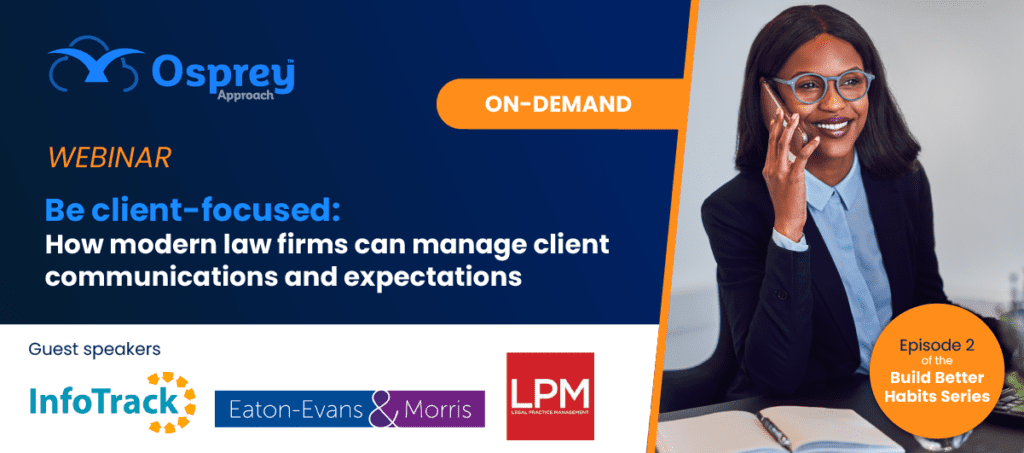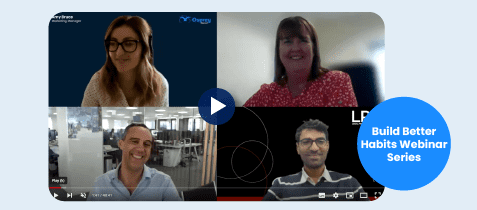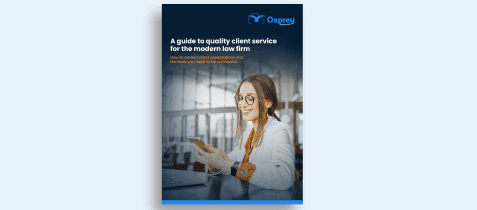Contents
How law firms can manage client expectations effectively
For episode two of the Build Better Habits webinar series, we were joined by Sarah Charlton, CEO of Eaton Evans Morris, Gabriel Santos, national sales manager at InfoTrack, and Aftab Bose, editor of LPM. Our expert panel shared their practical tips and advice on how law firms can exceed growing client expectations by implementing a client-focused mindset and utilising technology to enhance collaboration.

What does a ‘client-focused’ mindset mean?
We begin by asking our panellists what a client-focused mindset means for modern law firms, and the resounding response was ensuring that clients are at the heart of all business decisions. Gab comments that, “decisions are often made from an operational perspective first… but they’re not thinking from the client’s perspective.
“Everything [should] start with empathy. Unless you’re putting yourself in someone else’s shoes, it’s hard to be client focused.”
Aftab agrees and highlights that the quality of customer service you deliver is one of the few things you can control, adding that “law firms have a unique model, especially in certain practice areas, that they’re not always able to guarantee an outcome. [This means that] your competitive advantage then shifts to the quality of service you deliver.”
When your client experience is the one thing you can control, it becomes a key consideration used by clients when comparing options and choosing a firm. It’s therefore important to be able to measure your service levels to promote your service to clients, but also enable improvement and growth. Sarah explains, “[you need to] evaluate how successful you are. It’s easy to have great marketing that says, ‘our clients are at the heart of our firm’, but how many firms actually do. Unless you ask clients and get feedback, it’s incredibly challenging to know.”
How can legal software help law firms better manage their client communications and stay client-focused?
Technology can assist with the heavy lifting of client communications. It can provide automation and digital tools that make replying, updating, and collaborating with clients easier. Aftab reveals data from the 2022 LPM Frontiers report that showed, “the top investment agenda for most SME law firms this year is CRM technology – client-focused tech is very much on the agenda.
“What’s important is to make sure when firms do invest in tech, that it’s integrated across their systems…to optimise the technology properly.”
Sarah agrees and says that integrating digital tools, and relying on Osprey Approach, helps them to aim towards an Amazon-like client experience. “We don’t have deep pockets like Amazon, but we use Osprey combined with other products, to replicate some service elements and it’s not that expensive.”
Legal software can provide flexibility to the methods and frequency of communication, helping to better manage workloads to avoid burnout, and reduce costly manual administration. However, Gab highlights the importance of a human approach: “Legal technology allows [lawyers] to complete [admin] tasks and save on billable time, which allows them to communicate with clients with a human element. Technology is not a substitute for a human interaction. It’s okay for firms to do 80% of the communication through automated milestones, emails, and reminders, however the human element is what’s going to make the difference.”
Eight habits law firms should adopt for effective client management
The panel agreed that modern law firms should focus on the following habits when implementing a client-focused strategy:
1. Define a service level agreement (SLA)
To ensure accountability across the firm, expectations need to be clear, so creating an agreement that states how you’re going to communicate with clients is key as Gab explains: “I don’t see it in firms often, but when I do it’s very successful, and that is setting up and abiding by an agreement of how you plan to service your clients.” Aftab agrees and believes regular check-ins with clients should form part of the standard service. “What’s worked well for firms is having a separate team – perhaps a customer success role – checking in independently with the client at different points in their journey.”
2. Choose your value proposition
You need to consider why clients would choose you over your competitors, and Sarah suggests considering your purpose and wider business goals. For example, thinking about your sustainability and environmental impact, offering apprenticeships, and helping the local community, or becoming a B Corp firm to show your commitment.
3. Accountability
Communicate goals and SLAs to the wider team and ensure they’re reminded regularly of what’s expected to ensure accountability. Gab believes that leadership needs to empower employees to provide a higher level of service and, “that will only happen once you set expectations and consistently communicate those to your staff.”
4. Reward staff
To reinforce the behaviour you expect, it’s important to reward staff for achieving goals and improving performance. Sarah says that at her firm they reward people who receive good reviews, which helps to instil a client-focused culture across the firm.
5. Align values with success measures
To help reward employees and incentivise change, it’s important to measure the firm’s success towards the goal. Aftab warns that current measures of success don’t always align to a client-focused strategy and points out that “billable hours tend to be the measure of success, but if you pivot away from that and look at reviews and service delivery, you’ll gradually move towards a client-focused team.”
6. Keep data hygienic
When utilising technology to enhance the client service it’s important to ensure the data you input is cleansed and accurate. Aftab explains how quality data can be used to inform creative ways of utilising your technology, but “the opposite is true, if the data isn’t hygienic, pretty much everything else will be a mess and take extra time. If you have clean data, then the potential is limitless.”
7. Hire people from different sectors
Sarah says that teaching how a law firm is structured is simple but teaching people skills – like how to diffuse a difficult situation – isn’t. In the roles where it’s applicable, she advises to focus on hiring individuals who have a client-focused background rather than just a legal sector background, adding that, “we target people who have worked in hospitality because first impressions count.”
8. Incentivise word of mouth
Feedback from your clients is invaluable, so incentivise word of mouth. Gab believes that a recommendation from a client is the best way to build credibility and highlight the quality of service. He recommends that firms, “put your solicitors’ reviews on your webiste… and learn from the feedback to understand what is and isn’t working for you.”
Who is responsible for ensuring client-focused habits stick?
The panel had differing views on this point, but a common theme is that the mindset needs to be a priority for it to be successful.
Gab believes that a culture shift can only work if it comes from the top down and suggests, “identify who at the top of your organisation has the client-focused traits you’re looking for and can effectively communicate and lead by example.
“It’s important to have a clear strategy and then make sure people are held accountable.” Gab says it goes back to setting SLAs and aligning the firm’s goals, and then everyone can be clear of what is expected.
Sarah agrees that top down is ideal but, “that’s a utopia land and in reality, I think you can spread [the mindset] from the middle. It’s all about what’s acceptable and what isn’t. Even if you don’t have buy-in from senior partners from the get-go, if the rest of the firm prioritise the client, then the business can become successful because everyone has been client-focused.”
Aftab agrees that there can often be a divide between those who service the clients and those who take care of the revenue, investments, and operational decisions. And by ensuring those business decisions have the client in mind will help to implement a client-focused mindset throughout. Aftab observes that, “client centricity tends to be entrenched in purpose. What helps many firms is to have a written set of values that says, ‘this is the purpose of our firm and it’s why we do what we do’.”
Implement client-focused business habits for long-term success
This episode has highlighted the importance of understanding your client’s needs and letting that shape every business decision across the firm. For modern law firms to stay competitive, it’s important they focus not only on what they deliver, but how they deliver it. And so, controlling those aspects of your operational strategy and service can help you secure five-star reviews, increase recommendations, and win more clients.
To implement a client centric culture throughout the firm it’s important to have a clear strategy, a defined agreement on what’s expected, measurable performance metrics, and the right digital tools to provide support for the team so they can deliver an empathetic, but profitable service.
Having a client-focused culture is one of four habits that we’ve outlined, which modern law firms should adopt for long-term success.
We’ve covered all four habits in our Build Better Habits webinar series, which you can watch on-demand now.





